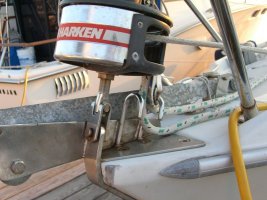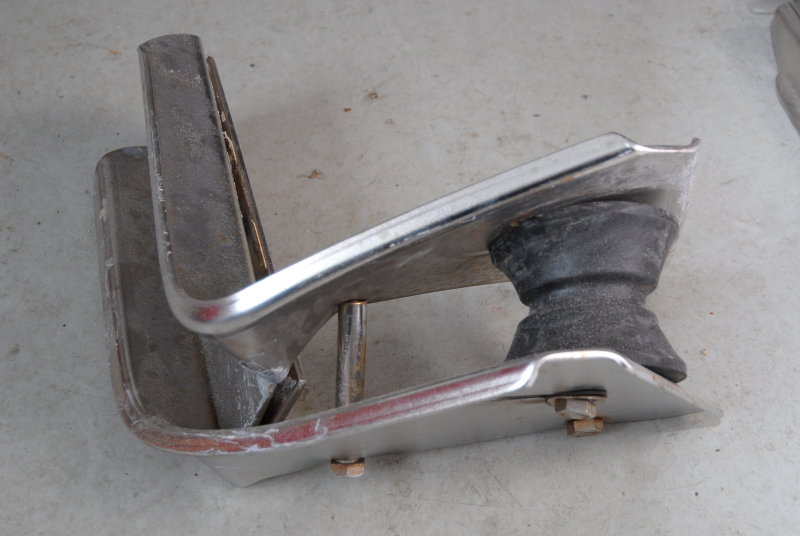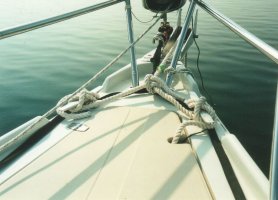Akavishon
Member III
After a month long cruise with numerous nights spent on anchor, I've come to realize that my current anchoring setup is not really ideal. I'm turning to the forum for guidance what can be done to improve it, within reasonable budget constraints 
I have a 35lbs CQR on 25' of chain and 200' nylon rode, which I rather like, and feel safe with. It sets well, and holds well, it seems. The anchor is held in place by a rather short (and undersized, it seems) bow anchor roller, and a U-shaped stainless bracket with a safety pin, screwed into the foredeck, and holding the shank of the anchor. The bow roller seems welded to the bow stemhead fitting.
Here are some of the issues:
1) The front edges of the bow roller tend to chafe the nylon rode, as the boat sails around the anchor in stronger winds. I dealt with this using a plastic tube as chafe guard (minor issue).
2) The U-shaped bracket has wiggled lose and partially pulled the screws out of the deck. I can fix/rebed this, but I suppose it would be better to through-bolt them next time I take the anchor locker pan out (minor issue).
3) The chain/anchor shackle and chain/rope thimble seem too big for the bow roller, and routinely get stuck when they run through it. Getting them unstuck usually risks a finger or two (medium issue).
4) The anchor shaft lies directly under the jib roller furler drum, with rather little clearance. To deploy the anchor, I have to reach over the bow pulpit and pull the anchor crown out horizontally until the shaft clears the furler drum, then put the chain onto the bow roller and lower the anchor. This is not too impractical when dropping the anchor, but a major PITA when weighing the anchor - I have to pull in all the rode and chain (dealing with issue #3 above), then reach over the pulpit to grab the anchor crown and push it back horizontally over the bow roller and under the roller furler drum.
After a month of anchoring in all kinds of conditions, I am sick and tired of bow acrobatics and risking my fingers and my lower back with this issue. Attached is a photo showing this miserable setup ... ideas what to do about it would be appreciated!
TIA - Zoran
I have a 35lbs CQR on 25' of chain and 200' nylon rode, which I rather like, and feel safe with. It sets well, and holds well, it seems. The anchor is held in place by a rather short (and undersized, it seems) bow anchor roller, and a U-shaped stainless bracket with a safety pin, screwed into the foredeck, and holding the shank of the anchor. The bow roller seems welded to the bow stemhead fitting.
Here are some of the issues:
1) The front edges of the bow roller tend to chafe the nylon rode, as the boat sails around the anchor in stronger winds. I dealt with this using a plastic tube as chafe guard (minor issue).
2) The U-shaped bracket has wiggled lose and partially pulled the screws out of the deck. I can fix/rebed this, but I suppose it would be better to through-bolt them next time I take the anchor locker pan out (minor issue).
3) The chain/anchor shackle and chain/rope thimble seem too big for the bow roller, and routinely get stuck when they run through it. Getting them unstuck usually risks a finger or two (medium issue).
4) The anchor shaft lies directly under the jib roller furler drum, with rather little clearance. To deploy the anchor, I have to reach over the bow pulpit and pull the anchor crown out horizontally until the shaft clears the furler drum, then put the chain onto the bow roller and lower the anchor. This is not too impractical when dropping the anchor, but a major PITA when weighing the anchor - I have to pull in all the rode and chain (dealing with issue #3 above), then reach over the pulpit to grab the anchor crown and push it back horizontally over the bow roller and under the roller furler drum.
After a month of anchoring in all kinds of conditions, I am sick and tired of bow acrobatics and risking my fingers and my lower back with this issue. Attached is a photo showing this miserable setup ... ideas what to do about it would be appreciated!
TIA - Zoran





